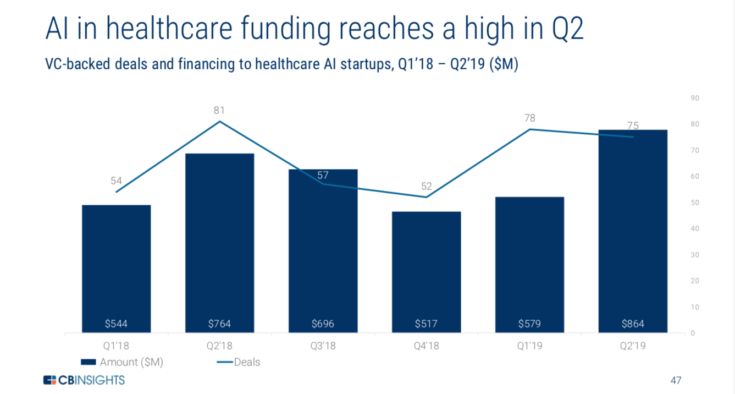Industry leaders anticipate that the use of artificial intelligence in medical imaging will have a substantial clinical impact, ushering in an opportunity to significantly improve decision support in medical image interpretation. In this post, we cover a variety of promising medical imaging applications for AI and machine learning—including diagnosing cancer and brain aneurysms—as well as recent regulatory developments.
Metrics Climb
CB Insights reports that healthcare-related AI investment totaled $1.44 billion in the first half of 2019, putting investment in the space on track to surpass the prior year, in which investment reached $2.5 billion. Much of the attention to date has surrounded applications in medical imaging or radiology.

The National Center for Biologic Information (NCBI) reports that publications covering AI in radiology have steeply increased in recent years. Between 2016 and 2017, the number of articles published on the topic ranged from 700 to 800. That's compared to 100 to 150 articles published between 2007 and 2008. In addition, more than half of recent articles focused on applications related to magnetic resonance imaging (MRI) or computed tomography (CT). And January saw the launch of a peer-reviewed journal devoted to AI in medical imaging: Radiology: Artificial Intelligence.
NIH Lends Support
One boost has come from the National Institutes of Health (NIH). The agency has helped the cause of leveraging machine learning and deep learning in medical imaging by releasing a vast collection of CT images. Researchers can access 32,000 images to develop new applications. The NIH has also developed a roadmap for the use of AI in medical imaging, providing guidance to stakeholders on how they can collaborate to implement these innovative technologies.
Case Studies Demonstrate Potential
A number of promising results from recent studies are another driver. Machine learning (ML) and deep learning (DL) technologies have not made their way to the clinic yet, but some impressive and widely reported studies have shown ML and DL's potential to improve diagnostics.
A study done in 2017 tested a DL network's ability to determine from radiology scans which patients had breast cancer and which did not. The network scored 100% accuracy, and it outperformed human pathologists when it came to delineating the extent of the tumor's boundaries and spread.
In a study conducted earlier this year, a DL system went up against 101 radiologists in identifying and rating cancers in mammograms. The AI system outperformed all but the most experienced radiologists.
Meanwhile, in a study at the University of California, San Francisco, an algorithm was able to make a "highly accurate" prediction of which patients have dementia, Alzheimer's disease or a mild cognitive impairment based on PET scans.
A team of researchers have applied AI in radiology, called radiomics, and ML to develop a new framework to better predict the progression of prostate cancer. This allows radiologists to differentiate between low- and high-risk cases of prostate cancer and reduce the risk of under- or over-treating a patient.
A Regulatory Path in the Works
The U.S. Food and Drug Administration had approved 26 AI applications in healthcare as of the first of the year. Many of these are consumer wearable related, but others are designed to enhance the work of clinical radiologists.
However, the FDA has not yet developed a way to evaluate a medical technology that continues to learn and improve, such as ML and DL. AI-related approvals or clearances to date have been based on closed data sets.
The agency is actively working on this issue. In April it issued a proposed regulatory framework for AI/ML devices, but will likely take a couple of years to develop firm guidelines.
In PACS or Out?
Before any AI tool can be incorporated into clinical practice, the developers need to determine what path they are going to take into the clinic.
Medical imaging is stored and accessed through a common technology known as "picture archiving and communications system," or PACS. AI tools can be integrated into these existing systems or developed as a stand-alone overlay. Institutions will no doubt have different preferences about how to integrate new technologies into the existing legacy systems, so there may not be a one-size-fits-all solution.
Speaking of Legacies...
Much of the attention on AI in medical imaging is focused on efforts by early-stage researchers and startups. However, CB Insights' most recent Global Healthcare Report notes that the established companies in medical imaging, including Siemens, GE and Philips, rank among the top AI patent applicants.

For example, GE Healthcare and Fujitsu recently announced a new collaboration to develop AI solutions to quickly diagnose brain aneurysms.
Summary
With its large image-based data sets, medical imaging is a natural fit for ML/DL tools. However, as is often the case with emerging technologies, a regulatory framework needs to be developed and legacy systems and processes will need to be adapted before the full potential of these tools can be realized in a clinical setting.
Originally published September 19, 2019 on Fenwick's Life Sciences Legal Insights blog.
The content of this article is intended to provide a general guide to the subject matter. Specialist advice should be sought about your specific circumstances.

